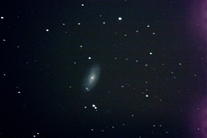m088_1600iso_300sec_f065_12.jpg
m088_1600iso_300sec_f065_12.jpg
(m088_1600iso_300sec_f065_12.jpg)
M88
304mm f/10.0 lx200gps 12" scope at f/6.5 with taurus tracker III focal reducer, canon 300d camera at 1600iso. Single 5min exposure. Taken at Hildebrandt Ranch.
Messier 88
Spiral Galaxy M88 (NGC 4501), type Sc, in Coma Berenices
Right Ascension 12 : 32.0 (h:m)
Declination +14 : 25 (deg:m)
Distance 60000 (kly)
Visual Brightness 9.6 (mag)
Apparent Dimension 7x4 (arc min)
Discovered 1781 by Charles Messier.
Excerpt from seds.org:
Messier 88 (M88, NGC 4501) is one of the brighter spiral galaxies in the Virgo Cluster of Galaxies.
M88 is one of the eight galaxies found on March 18, 1781 by Charles Messier in the Coma-Virgo region, and described by him as "nebula without stars," "one of the faintest" objects, and similar to M58. On that most successful discovery day, Messier also found globular cluster M92, to bring his daily score to 9 cataloged objects.
M88 is among the first recognized as a spiral galaxy, and listed by Lord Rosse as one of 14 "spiral nebulae" discovered to 1850.
This bright member of the Virgo Cluster of galaxies is nicely symmetrical and of multiple-arm type. As its equatorial plane is inclined by about 30 degrees to the line of sight, its appearance resembles a bit that of the Andromeda galaxy M31, and its outline is an elongated ellipse of angular dimension between 7x4 to 8x3 arc minutes, according to different sources, corresponding to a linear diameter of about 130,000 light years. This is one of the more rewarding galaxies in the Virgo cluster for smaller instruments!
This galaxy is one of the Virgo cluster members with a considerable peculiar velocity away from us, as it is receding with about 2000 km/sec.
Type Ia Supernova 1999cl occurred in M88 on May 28, 1999, was discovered on May 29, 1999 at magnitude 16.4 and reached magnitude 13.6..13.8 (June 5, 1999).
